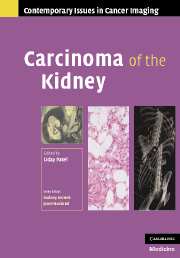Book contents
- Frontmatter
- Contents
- Contributors
- Series foreword
- Preface to Carcinoma of the Kidney
- 1 Renal cell cancer: overview and immunochemotherapy
- 2 Pathology of adult renal parenchymal cancers
- 3 Familial and inherited renal cancers
- 4 Radiological diagnosis of renal cancer
- 5 Staging of renal cancer
- 6 The case for biopsy in the modern management of renal cancer
- 7 Imaging characteristics of unusual renal cancers
- 8 Surgery for renal cancer: current status
- 9 Ablation of renal cancer
- 10 Post-treatment surveillance of renal cancer
- 11 Imaging for nephron-sparing procedures
- Index
- Plate Section
- References
9 - Ablation of renal cancer
Published online by Cambridge University Press: 08 August 2009
- Frontmatter
- Contents
- Contributors
- Series foreword
- Preface to Carcinoma of the Kidney
- 1 Renal cell cancer: overview and immunochemotherapy
- 2 Pathology of adult renal parenchymal cancers
- 3 Familial and inherited renal cancers
- 4 Radiological diagnosis of renal cancer
- 5 Staging of renal cancer
- 6 The case for biopsy in the modern management of renal cancer
- 7 Imaging characteristics of unusual renal cancers
- 8 Surgery for renal cancer: current status
- 9 Ablation of renal cancer
- 10 Post-treatment surveillance of renal cancer
- 11 Imaging for nephron-sparing procedures
- Index
- Plate Section
- References
Summary
Introduction
Image-guided ablation is playing an increasingly important role in the management of small renal tumors. The potential benefits of image-guided ablation over traditional surgery include decreased morbidity and inpatient stay, decreased costs and the potential to treat patients who are poor surgical candidates by a minimally invasive approach. All available ablation techniques are based around the principle of utilizing thermal energy (whether it be hot or cold) to destroy tumor tissue. The aim of all ablation methods is to destroy malignant cells by invoking and maintaining cytotoxic temperatures within a tumor, including an adequate margin of surrounding normal tissue.
Cryotherapy
Cryotherapy has been used for many decades but only recently has there been a resurgence of interest in this technique as a result of the introduction of narrow gauge Argon probes (rather than the historical larger nitrogen probes) enabling treatment via a percutaneous approach. Multiple probes are inserted into the target lesion (either under imaging guidance or direct vision as an open surgical or laparoscopic procedure) and during the freeze cycle, an ice ball develops over approximately 15 minutes. Cryoablation uses multiple freeze–thaw cycles and requires temperatures of at least − 20 to − 30 ℃ to induce lasting tissue damage. There are several theories as to the mechanism of tissue destruction. These include protein damage as the cell dehydrates in response to freezing, damaging the cell membrane and intracellular enzymes. The formation of ice crystals within a cell also damages the intracellular organelles and cell membrane.
- Type
- Chapter
- Information
- Carcinoma of the Kidney , pp. 168 - 184Publisher: Cambridge University PressPrint publication year: 2007

